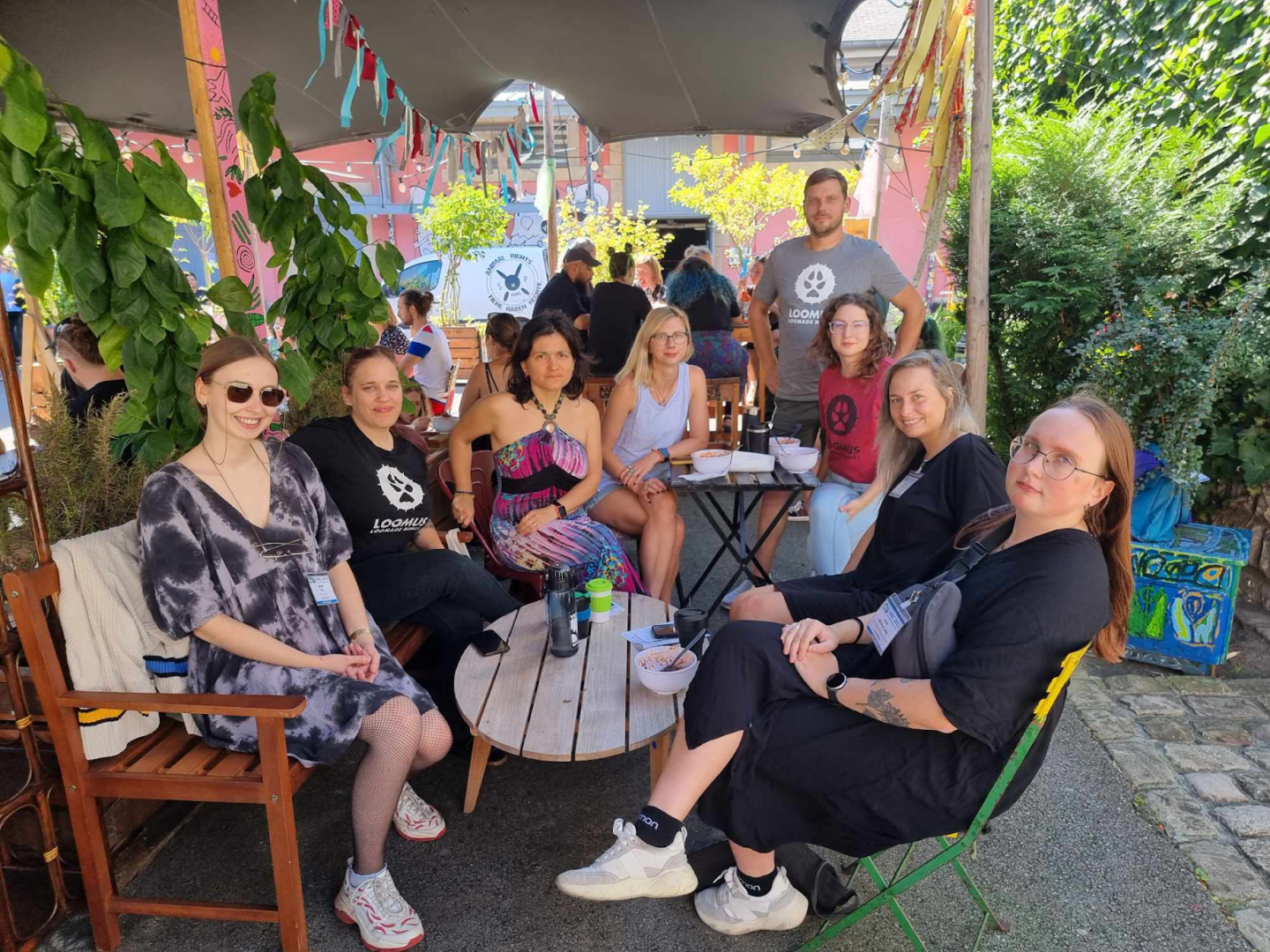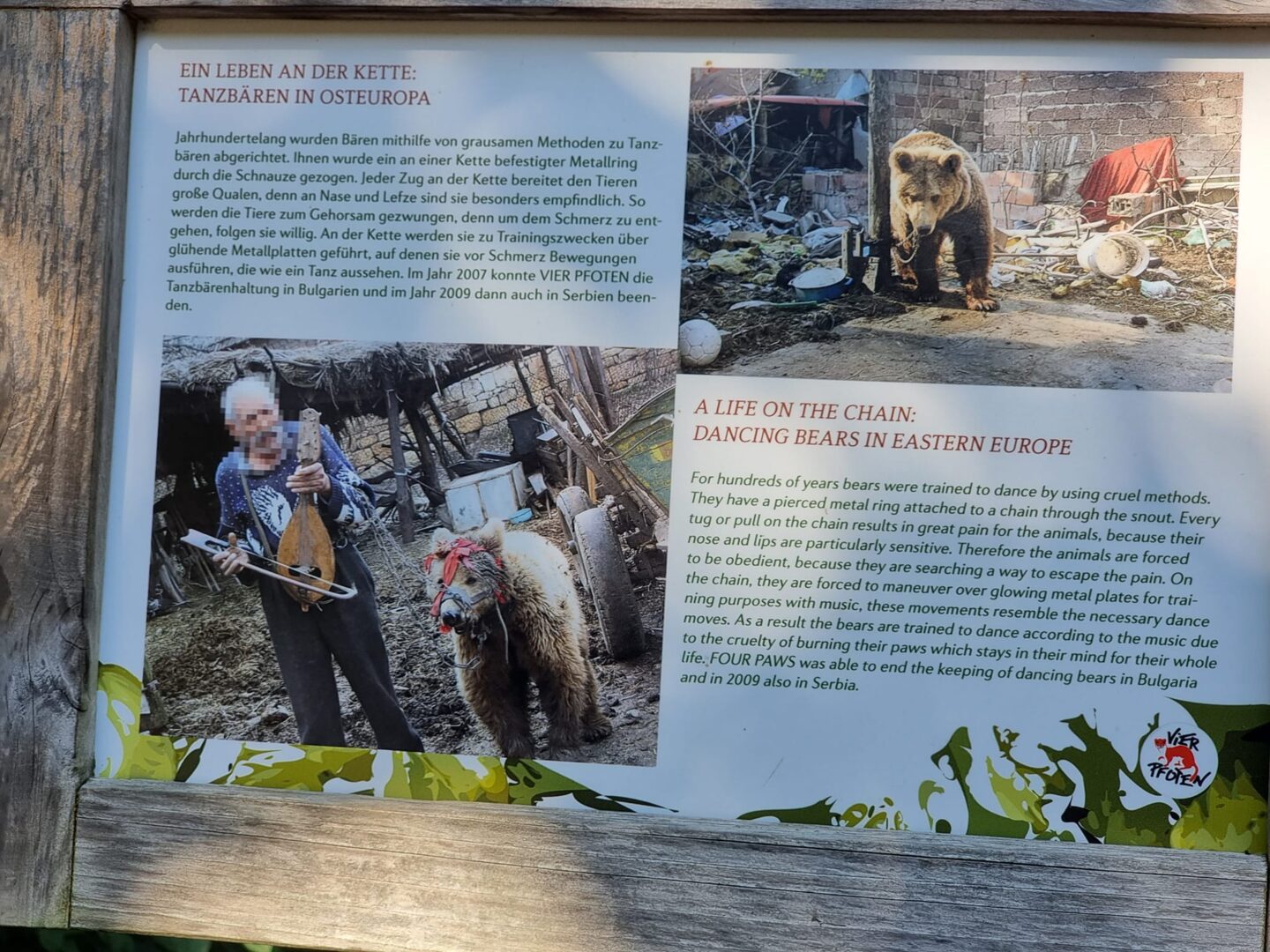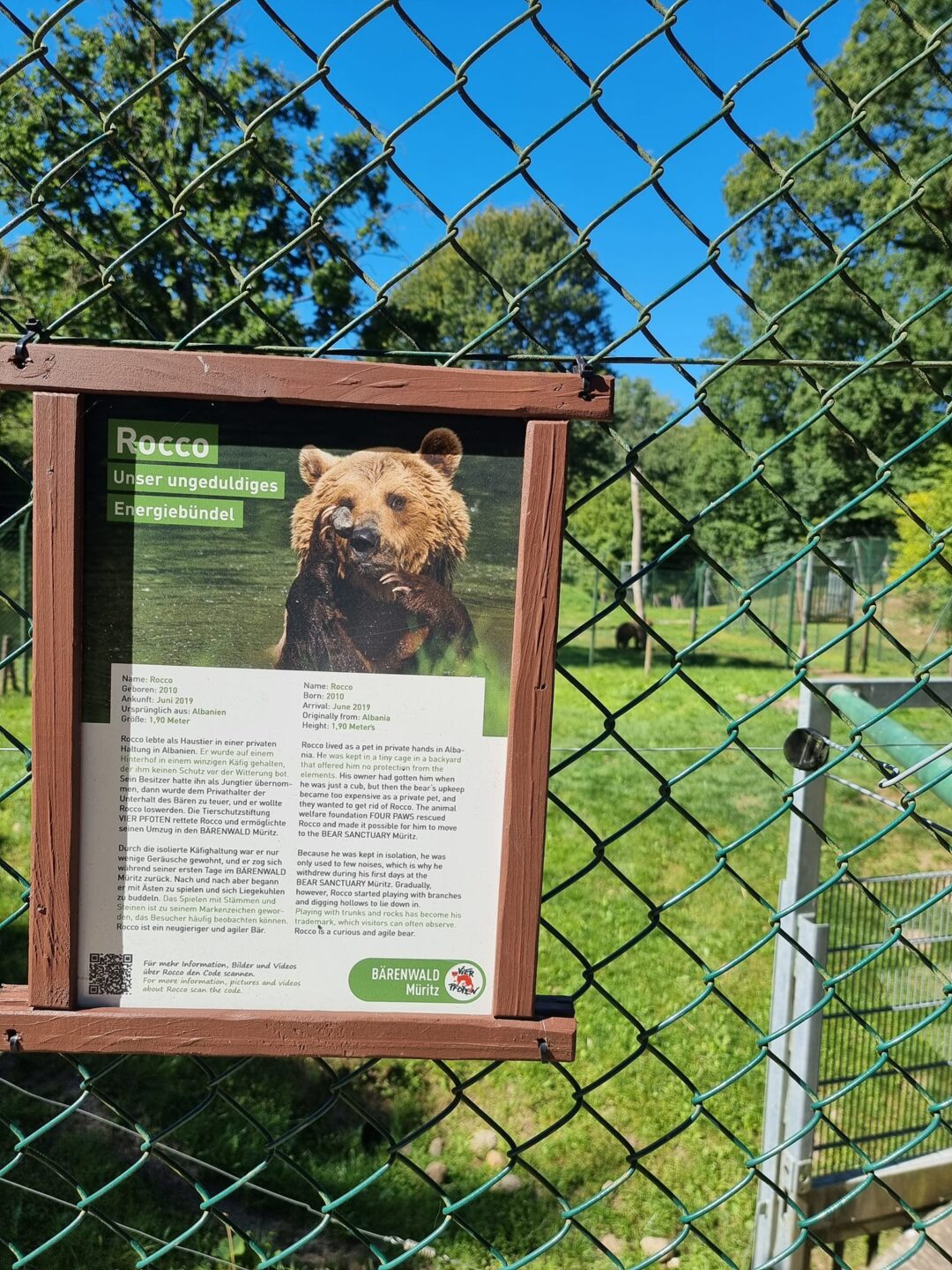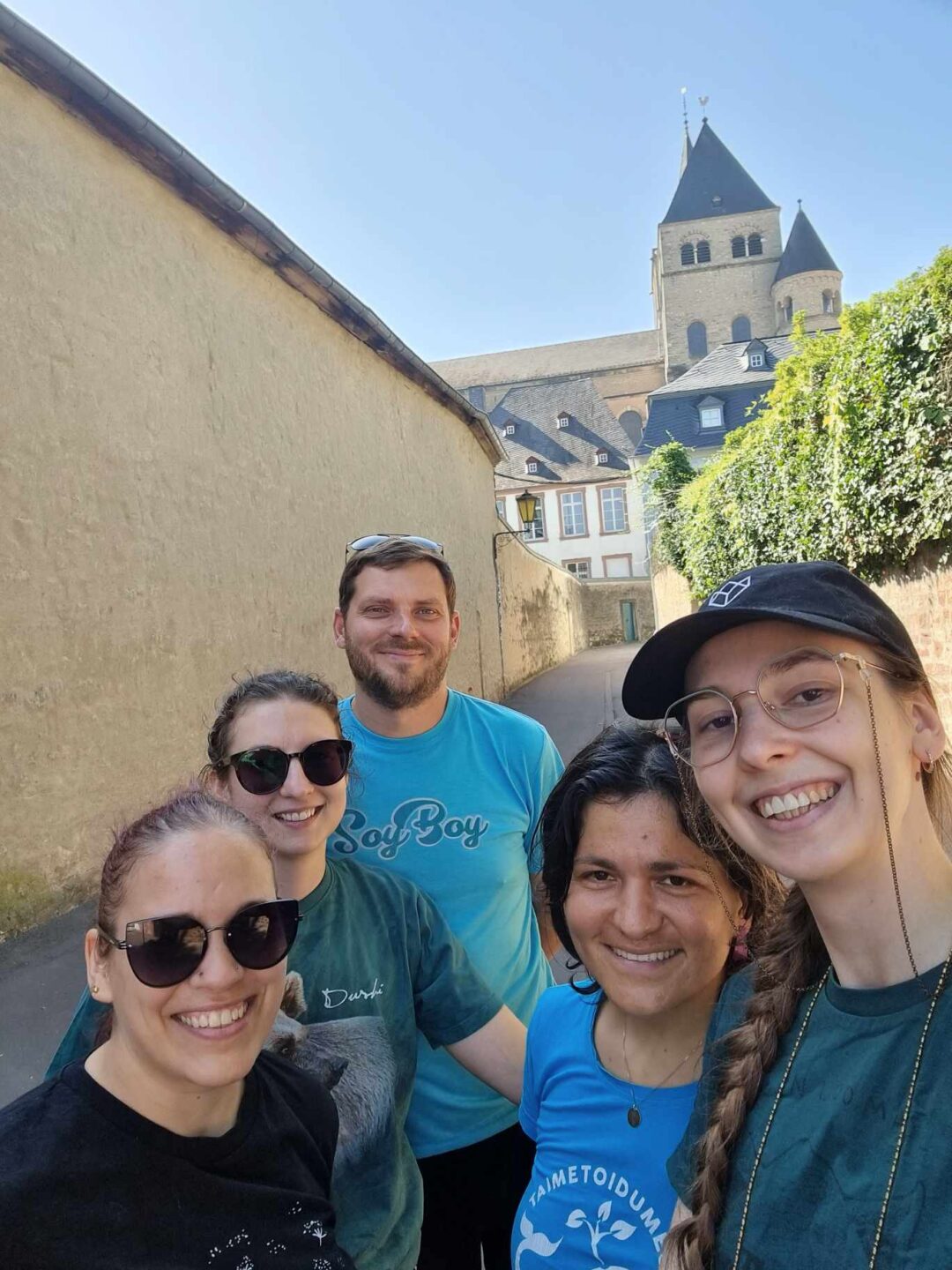In the beginning of September 2023, five of us Loomus members visited the International Animal Rights Conference in Luxembourg.

We wanted to avoid flying, so we rented a bigger car. We set out on the 5th of September in the early morning at 4 from Viljandi, Estonia. On the first day, we wanted to reach a lodge in the village of Broock in Germany, 1627 km from Viljandi. We made it! But only around 2am.
We were headed to Broock so that on the next morning we could visit a very special place near the village – the bear sanctuary Bärenwald Müritz. The organisation Vier Pfoten (Four Paws) has created a place where bears who have been abused by humans can have a home and as natural of an environment as possible. The bear sanctuary is an animal-considerate alternative to zoos, because while the latter is created for humans, the goal of a wildlife sanctuary is to offer a home for animals who cannot fare on their own in nature. The visit gave us a bit of faith in the existence of good people in an otherwise gloomy-looking world.




The drive to Luxembourg continues, we only had a bit more than 800 km left! The journey was full of fun adventures like any other trip! We arrived at the camp in Luxembourg around midnight and went quickly to sleep, so that the next day we could begin the conference with a workshop by Melanie Joy.
The workshop focused on infighting within organisations and between organisations. It can happen often that the bigger picture is forgotten, but for the animals and the movement it is important to understand that we are all sensitive people fighting for our values – to better the conditions of animals in this world. But which strategy and how to use it should be considered and discussed within your group; in the workshop we were able to practise how to do that effectively.
Two Loomus members, Kati Sulp and Martin Enn, have a bunny sanctuary, so they listened to Fernanda Garzi-Naranjo Ortega presentation on keeping an animal shelter in Mexico and how she has created an anti-speciesist network of shelters. The beauty of going to the conference in person is that you can also have a conversation with the presenters, share experiences, and gather information. Martin and Kati had just this opportunity with Fernanda.
Ronen Bar’s workshop “What is the story of planet Earth?” had the participants pretending they were an alien news-reporter and had to broadcast what is happening on Earth from the point of view of a bystander. Confusing, but at the same time an exciting and thought-provoking way to analyse life and the situation, and digest it later on your own. It is worth mentioning that Ronan is an awarded journalist, and the founder and director of the organisation Sentient.
Yasmin Ben Tzvi gave a presentation “Applying non-violence to your activism” which was completely astonishing in its own way. Yasmin is a long-time activist with Meat The Victims Israel and so she showed us different recordings from protests and of attacks against activists. Audience members, who were activists with different organisations, also shared their own experiences. It was extraordinary to try out on our own how to react with non-violence when facing a violent attack, and to try and protect yourself and others. It was a previously agreed-upon scenario, but it still felt weirdly humiliating to respond to violence with non-violence. Respect for activists who go to protests grew tenfold…
Adelle Goodman’s presentation “Beyond sanctuary: What happens next?” focused on the different problems that arise when founding a sanctuary and emphasised that although you may wish to save all animals, you have to take into account your abilities and possibilities. Adelle travels the world and helps different animal rights organisations in their work.
On the very first day of the conference we discovered that the food offered at the conference was amazing and were continuously surprised at how well everything was organised! In the morning, those who wanted to could do yoga together and tune themselves for the day. The weather was consistently warm and sunny. The conference activities lasted from morning till evening, but still we all took a little time to explore and wander around the city of Esch where the conference took place.
On the second day, Melanie Joy held a workshop on the topic of preventing and recovering from burnout among vegans. Even more inspiring was Sarah Heiligtag’s “TransFARMing agriculture”. For ten years Sarah has been leading the vegan farm Hof Narr and a sanctuary in Switzerland. Soon after founding Hof Narr, other farmers started to contact her who wished to quit farming animals and still have a profit-turning business. And so the TransFARMing project was born, which by today has helped 125 farms quit farming animals and transition to a cruelty free path. We Animals Media has created a short documentary on the TransFARMing project. How wonderful it would be if a similar initiative took place in Estonia.
Susan Hartland’s workshop “How can we end hunting worldwide?” was an interesting listen because during the workshop activists from different countries shared their experiences related to hunting and discussed together different possibilities and strategies for future actions. One takeaway was how bringing very young children to hunting trips can leave them traumatised and that this should not actually be allowed.
An unexpected presentation was by India Kandel about how veganism is not a diet and how seeing veganism as a diet can actually be dangerous. India has battled with eating disorders and negative body image and through a personal experience revealed how talking about veganism only through food is harmful to vegans, activists and animals.
Luxembourg has free public transport, so using the opportunity we found a breathtakingly beautiful hiking trail that was only a 15-minute bus ride away from Esch. It began from the edge of a village called Kayl and went through Lèiffrächen nature reserve. The adventure was brought to an end by an empty water bottle and blistered feet!
One of the highlights of the conference was Max Watson’s introduction to the history of the Animal Liberation Front (ALF) in the cinema hall of Kulturfabrik Esch. The presentation, which was initially planned for only 45 minutes, went on for much longer, but still felt short as one could listen to Max for hours. We learned about ALF’s dealings from the imprisonment of Keith Mann to the hunger strike that ended with the death of Barry Horne in 2001, and their biggest achievements. The movement that exposed the horror of animal testing and greatly weakened the industry was termed terroristic, and the British government rushed to aid the companies, ignoring the cruel treatment of animals. Barry Horne was arrested in 1996 and he was sentenced to 18 years in prison. In prison, Barry went on hunger strike several times and demanded the government to stop animal testing. The longest hunger strike lasted for 68 days, his last one was a 15-day strike in the October of 2001, which ended with the activist’s death. Since the death of Barry, every year in the beginning of November, the amount of illegal direct-action activism rises and thousands of animals have been saved.
A presentation that deserves a mention might not initially seem very interesting, because it does not talk about saved animals, exciting campaigns, or victories, but was about legislation. Cynthia von Schlichten’s amazing presentation “An oxymoron in our midst: Relying on “animal protection” laws that do not really protect animals” brought out thought-provoking articles from animal rights laws around the world. The problem is mainly the fact that most of these laws do not actually protect animals, but rather protect profit, production, and other financial goals, or are actually in opposition with the goals of animal protection. For example, in the US there is a law which should protect the animals used in animal testing, but excludes mice, rats and birds, who make up about 95% of all the animals who are used there in animal testing. Estonian laws have the same issues. Do the laws pertaining to animals used for food actually protect animals? Because if they did, then the animal agriculture industry could not exist in its current form, at least not as an intensive industry.
The problem is mainly the fact that most of these laws do not actually protect animals, but rather protect profit, production, and other financial goals, or are actually in opposition with the goals of animal protection.
Although the conference had not yet ended, we had to set out on the way home on Sunday morning. We wandered around Germany’s oldest city Trier, admired the local architectural wonders, enjoyed amazingly tasty vegan ice cream, and arrived back home on the early morning of Tuesday.


Sanne Org, the project lead of Loomus project “Kahvliga kliimamuutuste vastu” (Against climate change with a fork) calculated that our trip emitted 198kg of CO2 equivalent per person. An average flight would have emitted around 700kg of CO2 equivalent per person.
We are all looking forward to the conference this year that begins on the 5th and runs until the 8th of September.
Check out the Internation Animal Rights Conference here: https://ar-conference.org/
